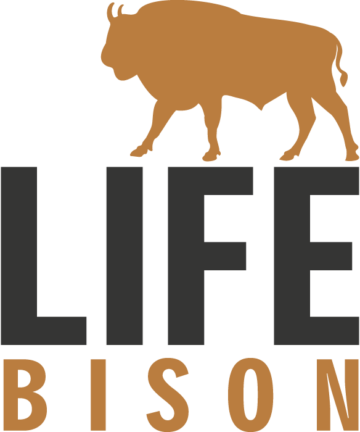Until they become acclimatised to fully wild conditions, bison reintroduced into the Southern Carpathians of Romania may be tempted to approach farms and villages looking for food, especially during periods of harsh weather. The local rewilding team monitors the bison – and provides villagers with guidance and information – to ensure both animals and people remain safe at all times.

In winter, and especially in times of heavy snow, bison do not have access to their main food – grass. While fully wild bison are accustomed to foraging in harsh conditions, those born and raised in captivity, and then newly introduced to the wild, are less capable. Until they adapt to their surroundings, they are sometimes attracted to more accessible food sources, such as haystacks.
As part of the Southern Carpathians rewilding team, bison rangers (locals from Armenis and Poieni rewilding areas), together with members of the WWF Romania team, work in the field to monitor the movement and health of reintroduced bison. If necessary, they intervene to keep the animals a safe distance from villages.
Interaction between bison and villagers in the Southern Carpathians rewilding area has happened in the past. A record is kept of these interactions and is used to improve future decision making regarding human-wildlife management.

In the winter of 2017, a female bison reintroduced into the Țarcu Mountains became separated from the large herd in the Bison Hillock area and came down into the village of Feneş. Having been transported from a zoo in 2015, she was very accustomed to the presence of humans and initially found it difficult to adapt to the wild and harsh winter conditions.
“The bison rangers and local WWF team constantly monitored the situation,” explains Bianca Stefanut, a communications officer attached to the Southern Carpathians rewilding team. “Following wildlife management rules, they intervened several times and guided the bison safely back towards the herd. The reaction of local people varied from concern to curiosity to pride.”
All reintroduced bison undergo a period of acclimatisation to local natural and climatic conditions before they are fully released and become free roaming. However, some animals regain their survival instincts more slowly, depending on the frequency of their interactions with humans, and the feeding habits acquired at their former zoos and reserves.
“In extreme weather conditions, such as those we have seen this winter, rangers will distribute hay, concentrate and mineralised salts in areas usually frequented by the bison,” explains Stefanut. “This means they are less likely to wander into villages. Electric fences have also been installed, but only in very high-risk localities.
“Over time, as the bison herds become wilder and wilder, we wil gradually stop employing such measures,” she continues. “But to foster co-existence at this early stage of the reintroduction programme these measures are critical.”

In terms of interacting with people, bison do not pose an immediate danger, but it must be remembered that they are still wild animals. Attracting them with food or engaging them directly is ill-advised, to avoid familiarity with humans and prevent damage to goods.
Here are a few points and tips to bear in mind, in order to prevent an unwanted bison encounter:
- Bison can weigh up to 1000 kilogrammes and can run at up toto 55 kph.
- Stay at least 100 metres away from any bison!
- Bison may appear docile, but can be defensive if they feel threatened.
- Do not approach bison to take pictures, or for any other reason. Your bison selfie isn’t worth your own life!
- Never feed bison.
- If a dangerous bison encounter does take place, inform bison rangers, the local authorities or police.
The Southern Carpathians rewilding teams recently distributed a brochure and poster in both rewilding areas, informing local people about the monitoring process and providing conflict prevention tips.

“When it comes to wild animals, it’s essential to analyse and preempt all possible risks,” says bison ranger Daniel Hurduzeu. “We rely heavily on the understanding and goodwill of the local community, of which we ourselves are members. We are all part of this project, and all of us have to learn how to live alongside wild nature.”
- Learn more about Rewilding Europe’s work in the Southern Carpathians here.
- More information about the LIFE Bison project can be viewed here.
- Track reintroduced bison in the Southern Carpathians through the European Safari Company website here.
- Follow the action that takes place in the field on the Rewilding Southern Carpathians Facebook and Twitter pages.
